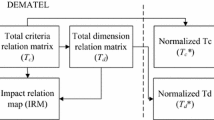Abstract
Software packages evaluation and selection is one of the most important activities encountered by software as a service (SaaS) users in the high performance networked computing environment, especially for the small or medium-sized enterprises. In this paper, we propose a framework for SaaS software packages evaluation and selection by combining the virtual team (VT) and the BOCR (benefits, opportunities, costs, and risks) of the analytic network process (ANP). Different from the traditional application of the BOCR model of ANP, the proposed VT-BOCR model attempts to solve the complex ANP model and overloaded pairwise comparisons by decomposing the tasks to four parts, and performed by benefits virtual team (B-VT), opportunities virtual team (O-VT), costs virtual team (C-VT), and risks virtual team (R-VT) separately. The interactive networked media on distributed environments not only makes the proposed framework possible without the limitations of time, space, and human resources, but also can take full advantage of the talent experts who are geographically dispersed. The proposed framework also shows great potentials for aiding practitioners and researchers concerned with the cloud services.
















Similar content being viewed by others
References
Benlian A, Hess T (2011) Opportunities and risks of software-as-a-service: findings from a survey of IT executives. Decis Support Syst 52:232–246
Camarinha-matos LM, Afsarmanesh H (2003) Elements of a base VE infrastructure. Comput Ind 51:139–163
Challa JS, Paul A, Dada Y, Nerella V, Srivastava PR, Singh AP (2011) Integrated software quality evaluation: a fuzzy multi-criteria approach. Int J Inf Process Syst 7(3):473–518
Cochran JK, Chen H (2005) Fuzzy multi-criteria selection of object-oriented simulation software for production system analysis. Comput Oper Res 32:153–168
Colombo E, Francalanci C (2004) Selecting CRM packages based on architectural, functional, and cost requirements: empirical validation of a hierarchical ranking model. Requir Eng 9:186–203
Davis L, Williams G (1994) Evaluation and selecting simulation software using the analytic hierarchy process. Integr Manuf Syst 5(1):23–32
Ebrahim NA, Ahmed S, Taha Z (2009) Virtual teams: a literature review. Aust J Basic Appl Sci 3(3):2653–2669
Fan M, Kumar S, Whinston AB (2009) Short-term and long-term competition between providers of shrink-wrap software and software as a service. Eur J Oper Res 196:661–671
Ergu D, Kou G, Peng Y, Shi Y (2011) A simple method to improve the consistency ratio of the pair-wise comparison matrix in ANP. Eur J Oper Res 213(1):246–259
Franch X, Carvallo JP (2003) Using quality models in software package selection. IEEE Softw 20(1):34–41
Garg SK, Versteeg S, Buyya R (2012) A framework for ranking of cloud computing services. Future Gener Comput Syst. doi:10.1016/j.future.2012.06.006
Jadhav AS, Sonar RM (2009) Evaluating and selecting software packages: a review. Inf Softw Technol 51:555–563
Jadhav AS, Sonar RM (2011) Framework for evaluation and selection of the software packages: a hybrid knowledge based system approach. The journal of Systems and Software
Kannan G, Vinay VP (2008) Multi-criteria decision making for the selection of CAD/CAM system. Int J Interact Des Manuf 2(3):151–159
Lai VS, Trueblood RP, Wong BK (1999) Software selection: a case study of the application of the analytical hierarchical process to the selection of a multimedia authoring system. Inf Manag 36:221–232
Lipnack J, Stamps J (2000) Why the way to work. virtual teams: people working across boundaries with technology, 2nd edn. Wiley, New York
Kou G, Lu Y, Peng Y, Shi Y (2012) Evaluation of classification algorithms using MCDM and rank correlation. Int J Inf Technol & Decis Mak 11(1):197–225
Meade LM, Presley A (2002) R&D project selection using the analytic network process (ANP). IEEE Trans Eng Manag 49(1):59–66
Morisio M, Tsoukias A (1997) IusWare: a methodology for the evaluation and selection of software products. IEEE Proc Softw Eng 144(3):162–174
Park J, Jeong HY (2012) The QoS-based MCDM system for SaaS ERP applications with social network. J Supercomput. doi:10.1007/s11227-012-0832-4
Peng Y, Kou G, Shi Y, Chen Z (2008) A descriptive framework for the field of data mining and knowledge discovery. Int J Inf Technol & Decis Mak 7(4):639–682
Peng Y, Kou G, Wang G, Shi Y (2011) FAMCDM: a fusion approach of MCDM methods to rank multiclass classification algorithms. Omega 39(6):677–689
Peng Y, Kou G, Wang G, Wu W, Shi Y (2011) Ensemble of software defect predictors: an AHP-based evaluation method. Int J Inf Technol & Decis Mak 10(1):187–206
Piccoli G, Powell A, Ives B (2004) Virtual teams: team control structure, work processes, and team effectiveness. Inf Technol People 17:359–379
Precup L, O’sullivan D, Cormican K, Dooley L (2006) Virtual team environment for collaborative research projects. Int J Innov Learn 3:77–94
Saaty TL (1996) Decision making with dependence and feedback: the analytic network process. RWS Publications, Pittsburgh. ISBN 0-9620317-9-8
Saaty TL (2001) Decision making with the analytic network process (ANP) and its ‘Super decisions’ software: the national missile defense (NMD) example. In: ISAHP 2001 proceedings, Bern, Switzerland, pp 2–4
Saaty TL (2006) The analytic network process, decision making with the analytic network process. International series in operations research & management science, vol 95. Springer, Berlin, pp 1–26
Saaty TL (2009) Theory and applications of the analytic network process. RWS Publications, Pittsburgh. ISBN 1888603-06-2
Saaty TL, Vargus LG (2011) The encyclicon, Vol 3: A dictionary of complex decisions using the analytic network process. RWS Publication, Pittsburgh
Sarkis J, Talluri S (2004) Evaluating and selecting e-commerce software and communication systems for supply chain. Eur J Oper Res 159:318–329
Shang JS, Tjader Y, Ding Y (2004) A unified framework fro multicriteria evaluation of transportation projects. IEEE Trans Eng Manag 51(3):300–313
Acknowledgements
This research was partially supported by grants from the National Natural Science Foundation of China #70901011, #71173028, #71373216 and #91224001, Program for New Century Excellent Talents in University (NCET-12-0086), and Academic Degree Programs Construction at Southwest University for Nationalities (#2012XWD-S1201).
Author information
Authors and Affiliations
Corresponding author
Rights and permissions
About this article
Cite this article
Ergu, D., Peng, Y. A framework for SaaS software packages evaluation and selection with virtual team and BOCR of analytic network process. J Supercomput 67, 219–238 (2014). https://doi.org/10.1007/s11227-013-0995-7
Published:
Issue Date:
DOI: https://doi.org/10.1007/s11227-013-0995-7




